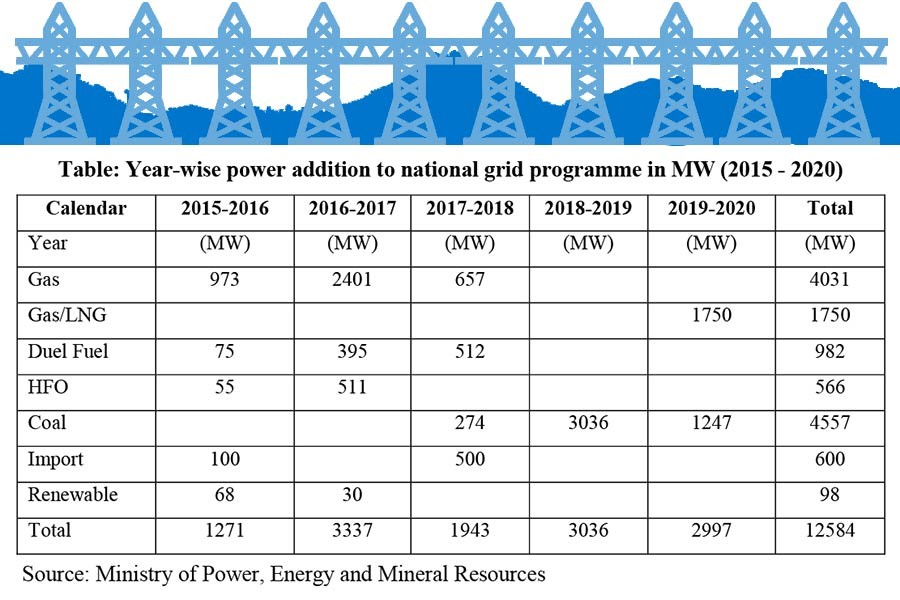In order to meet the increasing demand for power, the Bangladesh government is giving more emphasis towards increasing power generation. The government understands that in order to accomplish its aim of making Bangladesh a developed nation by 2041, it needs to ensure that its Gross Domestic Product (GDP) does not fall. The government also understands that the power sector cannot single-handedly deal with the mounting demand. This is why the government allowed the power generation by private sector.
A number of different government departments are working behind the scene to improve the situation with electricity in the country.
The Ministry of Power, Energy and Mineral Resources (MPEMR) is regulating the power sector of Bangladesh. The ministry has two divisions: Power Division and the Energy and Mineral Resources Division (EMRD). Power Division oversees all policies linked with power production, conduction and allotment along alternative sources of power generation like hydroelectricity.
The Power Cell wing under Power Division performs like a "Think Tank" and provides guidance while the Sustainable Renewable Development Authority (SREDA) oversees the improvement of sustainable and renewable power.
The import, distribution, exploration and extraction as well as pricing and other policies related to primary fuels are controlled by the Energy and Mineral Resources Division.
The installation of substations and power lines are done by the office of the Power License Board.
Bangladesh Power Development Board (BPDB) was created as a public sector organisation to help the power sector. This 100 per cent government-owned enterprise is responsible for power distribution & generation of the state-owned power plants. As of August 2017, the installed generation capacity (including Captive Power) was 15,761 MW. Additionally, BPDB procures power from private power plants. BPDB has recently initiated a massive expansion plan to add about 11,600 MW to the existing capacity over the next five years.
As a semi-autonomous government agency, Rural Electrification Board (REB) was established in 1977. REB looks after the distribution of electricity in rural areas. Over the past few years, the power connections through REB have been increasing steadily. It can be said that by providing electric connections, REB has had an indirect influence on the growth of activities in rural areas like business, farming, education and so on.
Now, in order to become a developed nation by 2041, Bangladesh needs to ensure an annual GDP growth rate of around 7.5 to 8.0 per cent. To achieve this target, a steady supply of power is necessary for both industries and households. Also, the total demand for power increases every year. This aspect needs to be addressed as well.
However, aid and grants from donor agencies are declining. On the other hand, level of foreign direct investment is nearly stationary. This is why the government allowed private sector into power generation. The government is encouraging private companies to set-up power plants under a Build-Own-Operate (BOO) model. Due to private sector power generation, the gap between demand and supply has diminished drastically.
According to the Power System Master Plan (PSMP) of 2010, total power production throughout the phase (FY2016 - FY2020) is expected to increase by 12,584 MW (not including captive power).
At the moment, the annual demand for power is increasing at a pace of 10 per cent. The demand varies throughout the day and night. The highest power generated during peak hours was 9,036MW (BPDB, 2016). During peak hours, the cost of energy being used is higher. As such, the power being provided by plants are naturally costlier. Cost load management is indispensable for better utilisation of capacity and minimum generation cost.
The dependence on gas and liquid fuel will persist until FY2018. Coal will become another fuel source for power generation by FY2019. Another LNG-based power plant should be built by FY2020. Power will also be imported.
According to the PSMP, the predictable demand for power would be 19,000 MW in 2021 and 34,000 MW in 2030.
In order to help set up more power plants, private and state-owned, banks and non-banking financial institutions (NBFIs) should come up with better financing facilities.
In order to sustain GDP growth required to become a middle-income nation by 2041, all related sectors need to dedicate their efforts at tackling the power crisis in the country.
Md. Julker Naim and Md. Hossain Al Gazzali are both Assistant Directors of Bangladesh Bank
[email protected] & [email protected]


